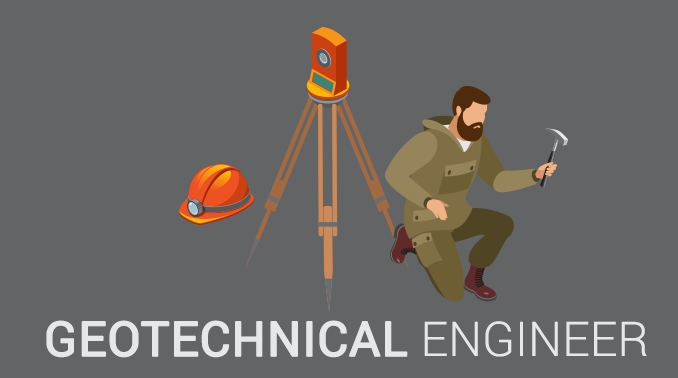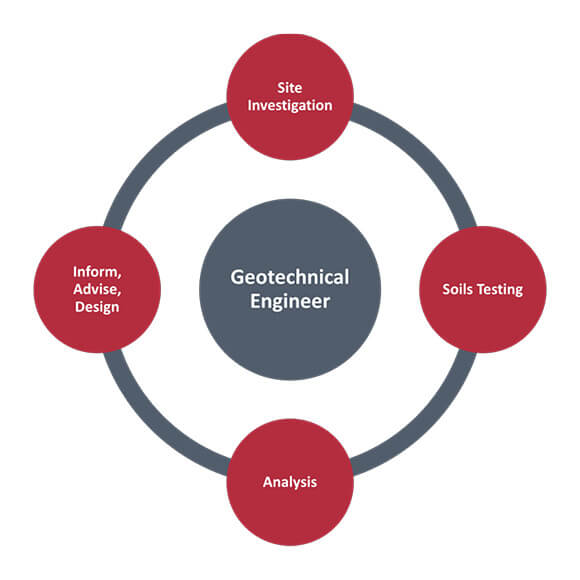The 5-Minute Rule for Geotheta
The 5-Minute Rule for Geotheta
Blog Article
The smart Trick of Geotheta That Nobody is Talking About
Table of ContentsThe Main Principles Of Geotheta Indicators on Geotheta You Should KnowGeotheta Fundamentals ExplainedAn Unbiased View of GeothetaThe Facts About Geotheta Revealed

They perform site examinations, gather samples, do lab examinations, and evaluate data to evaluate the suitability of the ground for building projects - Tailings Engineer. Based on their findings, geotechnical designers supply suggestions for structure style, slope security, retaining structures, and mitigation of geotechnical dangers. They team up with other experts, such as designers, architectural engineers, and building and construction groups, to ensure that geotechnical considerations are integrated into the overall job style and implementation
By evaluating the behavior and buildings of dirt and rock, they can recognize potential geotechnical dangers such as landslides, dirt settlement, or incline instability. Their know-how aids avoid failures or crashes that might endanger lives and residential property. Right here are some detailed tasks and responsibilities of a geotechnical designer: Site Investigation: Geotechnical engineers conduct site examinations to gather information on subsurface problems.
They translate the data to understand the buildings and behavior of the dirt and rock, including their toughness, leaks in the structure, compaction attributes, and groundwater problems. Geotechnical Analysis and Design: Geotechnical designers evaluate the information collected during site examinations to evaluate the stability and suitability of the site for building and construction jobs. They perform geotechnical calculations and modeling to assess variables such as bearing capacity, negotiation, slope stability, lateral earth pressures, and groundwater flow.
Geotheta - Questions
Structure Layout: Geotechnical engineers play a vital role in developing foundations that can securely support the designated framework. They analyze the soil problems and load requirements to determine the ideal structure type, such as shallow foundations (e.g., grounds), deep structures (e.g (https://www.4shared.com/u/w_sNL5Rc/ianhammond2191.html)., stacks), or specialized strategies like soil renovation. They take into consideration elements such as settlement limitations, bearing ability, and soil-structure interaction to establish optimum foundation layouts
They evaluate building and construction plans, screen website activities, and carry out area inspections to verify that the style referrals are followed. If unanticipated geotechnical problems emerge, they evaluate the circumstance and offer referrals for remediation or adjustments to the layout. Threat Assessment and Mitigation: Geotechnical engineers evaluate geotechnical dangers and risks linked with the job website, such as landslides, liquefaction, or dirt erosion.

Cooperation and Interaction: Geotechnical engineers work very closely with various other professionals entailed in a job, such as engineers, architectural engineers, and construction groups. Efficient communication and cooperation are necessary to integrate geotechnical considerations into the general project design and building and construction procedure. Geotechnical engineers offer technical knowledge, answer queries, and make sure that geotechnical needs are satisfied.
Geotheta Fundamentals Explained
Here are some kinds of geotechnical designers: Foundation Engineer: Structure engineers concentrate on designing and assessing foundations for structures. They analyze the dirt conditions, load requirements, and website attributes to identify the most proper structure type and design, such as superficial foundations, deep foundations, or specialized strategies like stack foundations.
They assess the aspects affecting slope security, such as soil properties, groundwater problems, and incline geometry, and develop techniques to avoid slope failings and mitigate risks. Earthquake Engineer: Quake designers focus on evaluating and developing frameworks to endure seismic forces. They examine the seismic danger of a website, examine soil liquefaction possibility, and create seismic design criteria to make certain the safety and security and resilience of structures during quakes.
They carry out area testing, collect samples, and assess the collected information to define the soil residential properties, geologic formations, and groundwater conditions at a website. Geotechnical Instrumentation Engineer: Geotechnical instrumentation engineers concentrate on monitoring and gauging the behavior of dirt, rock, and structures. They mount and keep instrumentation systems that keep track of aspects such as dirt negotiation, groundwater degrees, incline motions, and structural variations to evaluate efficiency and provide early cautions of potential concerns.
The 6-Minute Rule for Geotheta
They carry out tests such as triaxial examinations, debt consolidation tests, direct shear tests, and permeability tests to gather information for geotechnical analysis and design. Geosynthetics Engineer: Geosynthetics engineers concentrate on the design and application of geosynthetic materials, such as geotextiles, geogrids, and geomembranes. They utilize these products to enhance dirt security, strengthen slopes, give water drainage options, and control disintegration.
They tend to be investigatory people, which suggests they're intellectual, reflective, and investigative. They are curious, methodical, sensible, analytical, and rational. Some of them are also social, implying they're kind, charitable, cooperative, individual, caring, valuable, empathetic, skillful, and friendly - Consulting Engineers.
In the workplace atmosphere, geotechnical engineers make use of specialized software application devices to execute estimations, develop layouts, and examine data. They prepare records, testimonial job specifications, interact with customers and team members, and coordinate project tasks. The workplace setup offers a favorable setting for research, analysis, and official website cooperation with other specialists associated with the project.
3 Easy Facts About Geotheta Explained
They frequently go to task sites to conduct website examinations, examine geotechnical problems, and gather information for evaluation. These brows through entail taking a trip to various locations, often in remote or challenging surfaces. Geotechnical designers may execute dirt sampling, conduct examinations, and display building and construction activities to make sure that the geotechnical aspects of the job are being implemented properly.
Geotechnical designers additionally function in specialized geotechnical laboratories. In these facilities, they perform experiments, execute tests on soil and rock samples, and examine the engineering homes of the products. Geotechnical laboratory engineers function thoroughly in these settings, handling testing devices, running tools, and tape-recording data. They team up with various other laboratory staff to make certain exact and reliable testing outcomes.
Report this page